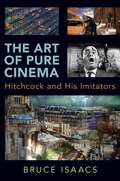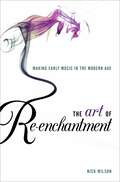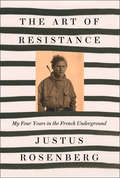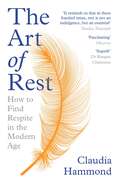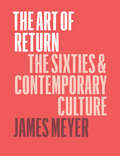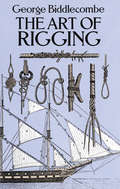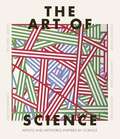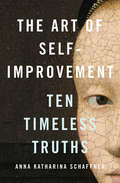- Table View
- List View
The Art of Pure Cinema: Hitchcock and His Imitators
by Bruce IsaacsIn a now-famous interview with François Truffaut in 1962, Alfred Hitchcock described his masterpiece Rear Window (1954) as "the purest expression of a cinematic idea." But what, precisely, did Hitchcock mean by pure cinema? Was pure cinema a function of mise en scène, or composition within the frame? Was it a function of montage, "of pieces of film assembled"? This notion of pure cinema has intrigued and perplexed critics, theorists, and filmmakers alike in the decades following this discussion. And even across his 40-year career, Hitchcock's own ideas about pure cinema remained mired in a lack of detail, clarity, and analytical precision. The Art of Pure Cinema is the first book-length study to examine the historical foundations and stylistic mechanics of pure cinema. Author Bruce Isaacs explores the potential of a philosophical and artistic approach most explicitly demonstrated by Hitchcock in his later films, beginning with Hitchcock's contact with the European avant-garde film movement in the mid-1920s. Tracing the evolution of a philosophy of pure cinema across Hitchcock's most experimental works - Rear Window, Vertigo, North by Northwest, Psycho, The Birds, Marnie, and Frenzy - Isaacs rereads these works in a new and vital context. In addition to this historical account, the book presents the first examination of pure cinema as an integrated stylistics of mise en scène, montage, and sound design. The films of so-called Hitchcockian imitators like Mario Bava, Dario Argento, and Brian De Palma are also examined in light of a provocative claim: that the art of pure cinema is only fully realized after Hitchcock.
The Art of Re-enchantment: Making Early Music in the Modern Age
by Nick WilsonIn the late 1960s, a new movement emerged championing historically informed 'authentic' approaches to performance. Heard today in concert halls across the world and in a library's worth of recordings, it has completely transformed the way in which we listen to 'old' music, while revolutionizing the classical music profession in the process. Yet the rise of Early Music has been anything but uncontroversial. Historically informed performance (HIP) has provoked heated debate amongst musicologists, performers and cultural sociologists. Did HIP's scholar-performers possess the skills necessary to achieve their uncompromising agenda? Was interest in historically informed performance just another facet of the burgeoning heritage industry? And was the widespread promotion of early music simply a commercial ruse to make money put forward by profit-driven record companies? In The Art of Re-enchantment: Making Early Music in the Modern Age, author Nick Wilson answers these and other questions through an in-depth analysis of the early music movement in Britain from the 1960s to the present day. While other books have examined the history of early music's revival, this interdisciplinary study is unique in its focus on how various constituencies actually made their living from the early music business. Through chapters discussing the professionalization of early music, the influence of institutions such as the BBC and record companies, and the entrepreneurial role of leading early music pioneers, this book will shed new light on one of the most fascinating and influential movements in 20th Century art music. The Art of Re-enchantment begins a much-needed conversation about the true value of art and authenticity today. This volume is a must have for early music fans and performers, music historians and musicologists with an interest in performance practice, and anyone interested in the production, distribution and consumption of music.
The Art of Reconciliation: Photography and the Conception of Dialectics in Benjamin, Hegel, and Derrida
by D. PeterssonDag Petersson offers a comprehensive critique of the philosophy that has dominated 200 years of modern thought, politics, economy, and culture. The basic question is this: why does dialectical metaphysics fail to keep what it promises? What is it about dialectics, that makes it fall into irreducibly distinct variations of itself, when all it promises is to synthesize, to reconcile and make whole what is fragmented and alien to itself? An undisciplined creativity intrinsic to completing reason comes to light through analyses of how dialectical systems begin. Every dialectical philosophy must account for its own birth, and it is at this point, when it also articulates its promise of universal synthesis, that the book discovers a desire for light-writing, or photography. Only the most immediate element light can mediate the necessary self-determination of thought at its origin. Light must begin to write. A philosophical critique of dialectics is therefore also a point of departure for a new aesthetic ontology of photography.
The Art of Resilience: The Lessons of Aeneas
by Andrea MarcolongoLucid, compelling, enlightening “Marcolongo is today’s Montaigne.”—André Aciman, author of Call Me by Your Name “Shows how languages gives us new ways of seeing and understanding the world."—The Guardian “Marcolongo uses the secrets of the Ancient Greek language to illuminate a new way of perceiving the world.”—Refinery29 From the international bestselling author of The Ingenious Language, a fascinating portrait of antiquity's most misunderstood, complex, and surprisingly modern hero. In times of peace and prosperity, it's natural to turn to Homer to learn about life's joys and passions; to experience the thrill and terror of war; to look for adventure in distant lands. But what about when things go wrong? What do we do when we find ourselves at the centre of one of the great upheavals of history? Then, writes Andrea Marcolongo, it's time to set the Iliad and the Odyssey aside, and call upon Aeneas. In her fresh, nuanced portrayal, Aeneas emerges as a multiform, deeply human hero, one who feels close to us in his vulnerability and capacity for empathy. His journey from the ruins of Troy to the shores of Italy holds many lessons for our present—chief among them that, even when all seems lost, through resilience and hope we can usher a new beginning.
The Art of Resistance: Cultural Protest against the Austrian Far Right in the Early Twenty-First Century (Austrian and Habsburg Studies #21)
by Allyson FiddlerWell before the far-right resurgence that has most recently transformed European politics, Austria’s 1999 parliamentary elections surprised the world with the unexpected success of the Freedom Party of Austria and its charismatic leader, Jörg Haider. The party’s perceived xenophobia, isolationism, and unabashed nationalism in turn inspired a massive protest movement that expressed opposition not only through street protests but also in novels, plays, films, and music. Through careful readings of this varied cultural output, The Art of Resistance traces the aesthetic styles and strategies deployed during this time, providing critical context for understanding modern Austrian history as well as the European protest movements of today.
The Art of Resistance: My Four Years In The French Underground: A Memoir
by Justus RosenbergA gripping memoir written by a 96-year-old Jewish Holocaust survivor about his escape from Nazi-occupied Poland in the 1930's and his adventures with the French Resistance during World War II
The Art of Rest: How to Find Respite in the Modern Age
by Claudia HammondShortlisted for the British Psychological Society Book Award for Popular Science Much of value has been written about sleep, but rest is different; it is how we unwind, calm our minds and recharge our bodies. The Art of Rest draws on ground-breaking research Claudia Hammond collaborated on: ‘The Rest Test’, the largest global survey into rest ever undertaken, completed by 18,000 people across 135 different countries. The survey revealed how people get rest and how it is directly linked to your sense of wellbeing. Counting down through the top ten activities which people find most restful, Hammond explains why rest matters, examines the science behind the results to establish what really works and offers a roadmap for a new, more restful and balanced life.
The Art of Return: The Sixties and Contemporary Culture
by James MeyerMore than any other decade, the sixties capture our collective cultural imagination. And while many Americans can immediately imagine the sound of Martin Luther King Jr. declaring “I have a dream!” or envision hippies placing flowers in gun barrels, the revolutionary sixties resonates around the world: China’s communist government inaugurated a new cultural era, African nations won independence from colonial rule, and students across Europe took to the streets, calling for an end to capitalism, imperialism, and the Vietnam War. In this innovative work, James Meyer turns to art criticism, theory, memoir, and fiction to examine the fascination with the long sixties and contemporary expressions of these cultural memories across the globe. Meyer draws on a diverse range of cultural objects that reimagine this revolutionary era stretching from the 1950s to the 1970s, including reenactments of civil rights, antiwar, and feminist marches, paintings, sculptures, photographs, novels, and films. Many of these works were created by artists and writers born during the long Sixties who were driven to understand a monumental era that they missed. These cases show us that the past becomes significant only in relation to our present, and our remembered history never perfectly replicates time past. This, Meyer argues, is precisely what makes our contemporary attachment to the past so important: it provides us a critical opportunity to examine our own relationship to history, memory, and nostalgia.
The Art of Return: The Sixties and Contemporary Culture
by James MeyerMore than any other decade, the sixties capture our collective cultural imagination. And while many Americans can immediately imagine the sound of Martin Luther King Jr. declaring “I have a dream!” or envision hippies placing flowers in gun barrels, the revolutionary sixties resonates around the world: China’s communist government inaugurated a new cultural era, African nations won independence from colonial rule, and students across Europe took to the streets, calling for an end to capitalism, imperialism, and the Vietnam War. In this innovative work, James Meyer turns to art criticism, theory, memoir, and fiction to examine the fascination with the long sixties and contemporary expressions of these cultural memories across the globe. Meyer draws on a diverse range of cultural objects that reimagine this revolutionary era stretching from the 1950s to the 1970s, including reenactments of civil rights, antiwar, and feminist marches, paintings, sculptures, photographs, novels, and films. Many of these works were created by artists and writers born during the long Sixties who were driven to understand a monumental era that they missed. These cases show us that the past becomes significant only in relation to our present, and our remembered history never perfectly replicates time past. This, Meyer argues, is precisely what makes our contemporary attachment to the past so important: it provides us a critical opportunity to examine our own relationship to history, memory, and nostalgia.
The Art of Return: The Sixties and Contemporary Culture
by James MeyerMore than any other decade, the sixties capture our collective cultural imagination. And while many Americans can immediately imagine the sound of Martin Luther King Jr. declaring “I have a dream!” or envision hippies placing flowers in gun barrels, the revolutionary sixties resonates around the world: China’s communist government inaugurated a new cultural era, African nations won independence from colonial rule, and students across Europe took to the streets, calling for an end to capitalism, imperialism, and the Vietnam War. In this innovative work, James Meyer turns to art criticism, theory, memoir, and fiction to examine the fascination with the long sixties and contemporary expressions of these cultural memories across the globe. Meyer draws on a diverse range of cultural objects that reimagine this revolutionary era stretching from the 1950s to the 1970s, including reenactments of civil rights, antiwar, and feminist marches, paintings, sculptures, photographs, novels, and films. Many of these works were created by artists and writers born during the long Sixties who were driven to understand a monumental era that they missed. These cases show us that the past becomes significant only in relation to our present, and our remembered history never perfectly replicates time past. This, Meyer argues, is precisely what makes our contemporary attachment to the past so important: it provides us a critical opportunity to examine our own relationship to history, memory, and nostalgia.
The Art of Return: The Sixties and Contemporary Culture
by James MeyerMore than any other decade, the sixties capture our collective cultural imagination. And while many Americans can immediately imagine the sound of Martin Luther King Jr. declaring “I have a dream!” or envision hippies placing flowers in gun barrels, the revolutionary sixties resonates around the world: China’s communist government inaugurated a new cultural era, African nations won independence from colonial rule, and students across Europe took to the streets, calling for an end to capitalism, imperialism, and the Vietnam War. In this innovative work, James Meyer turns to art criticism, theory, memoir, and fiction to examine the fascination with the long sixties and contemporary expressions of these cultural memories across the globe. Meyer draws on a diverse range of cultural objects that reimagine this revolutionary era stretching from the 1950s to the 1970s, including reenactments of civil rights, antiwar, and feminist marches, paintings, sculptures, photographs, novels, and films. Many of these works were created by artists and writers born during the long Sixties who were driven to understand a monumental era that they missed. These cases show us that the past becomes significant only in relation to our present, and our remembered history never perfectly replicates time past. This, Meyer argues, is precisely what makes our contemporary attachment to the past so important: it provides us a critical opportunity to examine our own relationship to history, memory, and nostalgia.
The Art of Return: The Sixties and Contemporary Culture
by James MeyerMore than any other decade, the sixties capture our collective cultural imagination. And while many Americans can immediately imagine the sound of Martin Luther King Jr. declaring “I have a dream!” or envision hippies placing flowers in gun barrels, the revolutionary sixties resonates around the world: China’s communist government inaugurated a new cultural era, African nations won independence from colonial rule, and students across Europe took to the streets, calling for an end to capitalism, imperialism, and the Vietnam War. In this innovative work, James Meyer turns to art criticism, theory, memoir, and fiction to examine the fascination with the long sixties and contemporary expressions of these cultural memories across the globe. Meyer draws on a diverse range of cultural objects that reimagine this revolutionary era stretching from the 1950s to the 1970s, including reenactments of civil rights, antiwar, and feminist marches, paintings, sculptures, photographs, novels, and films. Many of these works were created by artists and writers born during the long Sixties who were driven to understand a monumental era that they missed. These cases show us that the past becomes significant only in relation to our present, and our remembered history never perfectly replicates time past. This, Meyer argues, is precisely what makes our contemporary attachment to the past so important: it provides us a critical opportunity to examine our own relationship to history, memory, and nostalgia.
The Art of Return: The Sixties and Contemporary Culture
by James MeyerMore than any other decade, the sixties capture our collective cultural imagination. And while many Americans can immediately imagine the sound of Martin Luther King Jr. declaring “I have a dream!” or envision hippies placing flowers in gun barrels, the revolutionary sixties resonates around the world: China’s communist government inaugurated a new cultural era, African nations won independence from colonial rule, and students across Europe took to the streets, calling for an end to capitalism, imperialism, and the Vietnam War. In this innovative work, James Meyer turns to art criticism, theory, memoir, and fiction to examine the fascination with the long sixties and contemporary expressions of these cultural memories across the globe. Meyer draws on a diverse range of cultural objects that reimagine this revolutionary era stretching from the 1950s to the 1970s, including reenactments of civil rights, antiwar, and feminist marches, paintings, sculptures, photographs, novels, and films. Many of these works were created by artists and writers born during the long Sixties who were driven to understand a monumental era that they missed. These cases show us that the past becomes significant only in relation to our present, and our remembered history never perfectly replicates time past. This, Meyer argues, is precisely what makes our contemporary attachment to the past so important: it provides us a critical opportunity to examine our own relationship to history, memory, and nostalgia.
The Art of Rigging
by George Biddlecombe"Few, today, can realize how important was the art of rigging a ship and reeving her gear in the days just old when all aloft was wood and hemp; or how great the part it has played in the building of Empire." — Introduction.Although mastery of the art of rigging is no longer required on board today's ships, legions of serious model ship builders who wish to rig their ships correctly need to learn the art in miniature. This book is widely considered the best manual ever produced on rigging the sailing ship. It is based on the extensively revised and updated 1848 edition prepared by Captain George Biddlecombe, a Master in the Royal Navy and former merchant seaman. The book is divided into five parts:The First Part contains an alphabetical explanation of terms and phrases used in rigging. The Second Part consists of directions for the performance of operations incidental to rigging and preparing it on shore, with a table of the comparative strength of chain and rope. The Third Part contains the progressive method of rigging ships. The Fourth Part contains a description of reeving the running rigging and bending the sails in addition to the rigging of brigs, yachts, and small vessels. The Fifth Part comprises tables of the quantities and dimensions of the standing and running rigging of ships, brigs, fore-and-aft schooners, and cutters, with the species, size, and number of blocks, hearts, dead-eyes, etc.Serious modelists, naval historians, armchair skippers — any sailing buff — will want to own a copy of The Art of Rigging. Complete and wonderfully clear, it is now available in its first inexpensive paperback edition. It belongs in every maritime library.
The Art of Roman Britain: New in Paperback
by Martin HenigWith the help of over 100 illustrations, many of them little known, Martin Henig shows that the art produced in Britannia--particularly in the golden age of Late Antiquity--rivals that of other provinces and deserves comparison with the art of metropolitan Rome. The originality and breadth of Henig's study is shown by its systematic coverage, embracing both the major arts--stone and bronze statuary, wall-painting and mosaics--and such applied arts as jewelery-making, silversmithing, furniture design, figure pottery, figurines and appliques. The author explains how the various workshops were organized, the part played by patronage and the changes that occurred in the fourth century.
The Art of Roman Britain: New in Paperback (British Archaeological Reports British Ser. #Vol. 41)
by Martin HenigWith the help of over 100 illustrations, many of them little known, Martin Henig shows that the art produced in Britannia--particularly in the golden age of Late Antiquity--rivals that of other provinces and deserves comparison with the art of metropolitan Rome. The originality and breadth of Henig's study is shown by its systematic coverage, embracing both the major arts--stone and bronze statuary, wall-painting and mosaics--and such applied arts as jewelery-making, silversmithing, furniture design, figure pottery, figurines and appliques. The author explains how the various workshops were organized, the part played by patronage and the changes that occurred in the fourth century.
The Art of Science: Artists and artworks inspired by science
by Heather Barnett Richard J BrightArt and science – they may seem like opposites, but throughout history there have been visionaries who have brought together these contrasting subjects.The Art of Science explores the work of 40 such artists and artist-scientists, uncovering how these innovators have designed futuristic technology centuries ahead of its time, investigated time and space through abstract art, and created sculpture informed by NASA technology.An expertly curated selection of artists from many different cultures and eras – including Huang Quan, Leonardo da Vinci, Johannes Vermeer, Anna Atkins, Olafur Eliasson and Anicka Yi – this book tells the story of the vital partnership between art and science, with over 200 lavish illustrations.
The Art of Science: A Natural History of Ideas
by Richard HamblynScience is about discovery, a journey towards knowledge. With authors as diverse as Galileo and Lewis Carroll, the extracts featured in this anthology span centuries and continents; they include startling revelations that changed the way we think and tackle more prosaic questions such as why the sea is salty; they consider the natural beauty of the snowflake and the man-made wonder of the first computer. What links them all is a desire to understand, explain and enrich the world, and the ability to communicate this in original, clear and engaging prose.
The Art of Science: From Perspective Drawing to Quantum Randomness
by Rossella Lupacchini Annarita AngeliniIn addition to linear perspective, complex numbers and probability were notable discoveries of the Renaissance. While the power of perspective, which transformed Renaissance art, was quickly recognized, the scientific establishment treated both complex numbers and probability with much suspicion. It was only in the twentieth century that quantum theory showed how probability might be molded from complex numbers and defined the notion of “complex probability amplitude”. From a theoretical point of view, however, the space opened to painting by linear perspective and that opened to science by complex numbers share significant characteristics. The Art of Science explores this shared field with the purpose of extending Leonardo’s vision of painting to issues of mathematics and encouraging the reader to see science as an art. The intention is to restore a visual dimension to mathematical sciences – an element dulled, if not obscured, by historians, philosophers, and scientists themselves.
The Art of Sculpture (The A. W. Mellon Lectures in the Fine Arts #3)
by Herbert ReadA stunning visual history of sculpture from prehistory through modernityThis book presents an aesthetic of sculptural art, which has too often submitted to the rule of architecture and painting. Herbert Read emphasizes the essential and autonomous nature of sculpture—&“Form in its full spatial completeness,&” in the words of British sculptor Henry Moore. The Art of Sculpture provides historical support and theoretical rigor to this conception. Along the way, this incisive and wide-ranging book takes readers on a breathtaking tour of great works of sculpture from prehistoric times to the modern era.Please note: All images in this ebook are presented in black and white and have been reduced in size.
The Art of Self-Improvement: Ten Timeless Truths
by Anna Katharina SchaffnerA brilliant distillation of the key ideas behind successful self-improvement practices throughout history, showing us how they remain relevant today Self-help today is a multi-billion-dollar global industry, one often seen as a by-product of neoliberalism and capitalism. Far from being a recent phenomenon, however, the practice of self-improvement has a long and rich history, extending all the way back to ancient China. For millennia, philosophers, sages, and theologians have reflected on the good life and devised strategies on how to achieve it. Focusing on ten core ideas of self-improvement that run through the world’s advice literature, Anna Katharina Schaffner reveals the ways they have evolved across cultures and historical eras, and why they continue to resonate with us today. Reminding us that there is much to learn from looking at time-honed models, Schaffner also examines the ways that self-improvement practices provide powerful barometers of the values, anxieties, and aspirations that preoccupy us at particular moments in time and expose basic assumptions about our purpose and nature.
The Art of Sinning: Sweeping Regency romance at its best! (Sinful Suitors #1)
by Sabrina JeffriesIf you love Julia Quinn's Bridgerton, you'll be enchanted by Sabrina Jeffries' Sinful Suitors!'Anyone who loves romance must read Sabrina Jeffries!' Lisa Kleypas, New York Times bestselling authorThe Art of Sinning is the first novel in the Sinful Suitors series by New York Times bestselling author Sabrina Jeffries. Sabrina's witty, sexy historicals will be loved by fans of Sarah MacLean, Eloisa James and Julia Quinn.At St. George's Club, guardians conspire to keep their unattached sisters and wards out of the clutches of sinful suitors. Which works fine...except when the sinful suitors are members...American artist Jeremy Keane refuses to return home and take over his father's business. He'd much rather sample bevvies of beauties abroad, in search of a model for the provocative masterpiece he's driven to paint. When he meets Lady Yvette Barlow at a London wedding, he realizes she's perfect for his work - and determines to capture the young heiress's defiant spirit and breathtaking sensuality on canvas.No stranger to scandal, Yvette agrees to be Keane's subject - in exchange for his help gaining entry to the city's brothels he knows intimately, so she can track a missing woman and solve a family mystery. But when their practical partnership leads to lessons in the art of sinning, can they find a bold and lasting love?For more utterly romantic and wonderfully witty historical romance, don't miss Sabrina's other dazzling series including, The Hellions of Halstead Hall, The School for Heiresses and The Royal Brotherhood.
The Art of Solidarity in the Middle Ages: Guilds in England 1250-1550
by Gervase RosserGuilds and fraternities, voluntary associations of men and women, proliferated in medieval Europe. The Art of Solidarity in the Middle Ages explores the motives and experiences of the many thousands of men and women who joined together in these family-like societies. Rarely confined to a single craft, the diversity of guild membership was of its essence. Setting the English evidence in a European context, this study is not an institutional history, but instead is concerned with the material and non-material aims of the brothers and sisters of the guilds. Gervase Rosser addresses the subject of medieval guilds in the context of contemporary debates surrounding the identity and fulfilment of the individual, and the problematic question of his or her relationship to a larger society. Unlike previous studies, The Art of Solidarity in the Middle Ages does not focus on the guilds as institutions but on the social and moral processes which were catalysed by participation. These bodies founded schools, built bridges, managed almshouses, governed small towns, shaped religious ritual, and commemorated the dead, perceiving that association with a fraternity would be a potential catalyst of personal change. Participants cultivated the formation of new friendships between individuals, predicated on the understanding that human fulfilment depended upon a mutually transformative engagement with others. The peasants, artisans, and professionals who joined the guilds sought to change both their society and themselves. The study sheds light on the conception and construction of society in the Middle Ages, and suggests further that this evidence has implications for how we see ourselves.
The Art of Solidarity in the Middle Ages: Guilds in England 1250-1550
by Gervase RosserGuilds and fraternities, voluntary associations of men and women, proliferated in medieval Europe. The Art of Solidarity in the Middle Ages explores the motives and experiences of the many thousands of men and women who joined together in these family-like societies. Rarely confined to a single craft, the diversity of guild membership was of its essence. Setting the English evidence in a European context, this study is not an institutional history, but instead is concerned with the material and non-material aims of the brothers and sisters of the guilds. Gervase Rosser addresses the subject of medieval guilds in the context of contemporary debates surrounding the identity and fulfilment of the individual, and the problematic question of his or her relationship to a larger society. Unlike previous studies, The Art of Solidarity in the Middle Ages does not focus on the guilds as institutions but on the social and moral processes which were catalysed by participation. These bodies founded schools, built bridges, managed almshouses, governed small towns, shaped religious ritual, and commemorated the dead, perceiving that association with a fraternity would be a potential catalyst of personal change. Participants cultivated the formation of new friendships between individuals, predicated on the understanding that human fulfilment depended upon a mutually transformative engagement with others. The peasants, artisans, and professionals who joined the guilds sought to change both their society and themselves. The study sheds light on the conception and construction of society in the Middle Ages, and suggests further that this evidence has implications for how we see ourselves.
